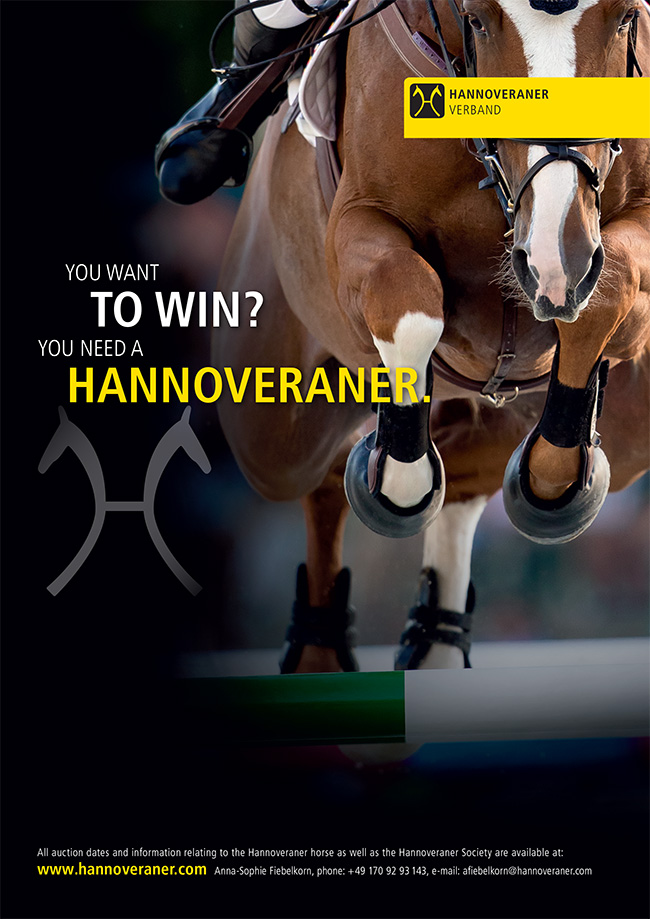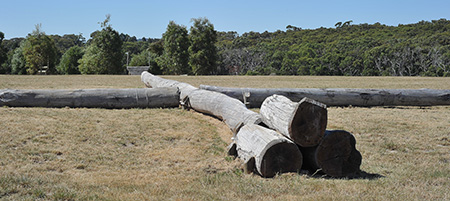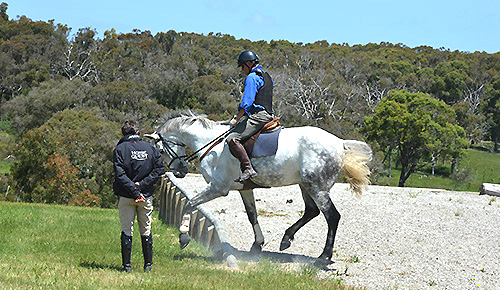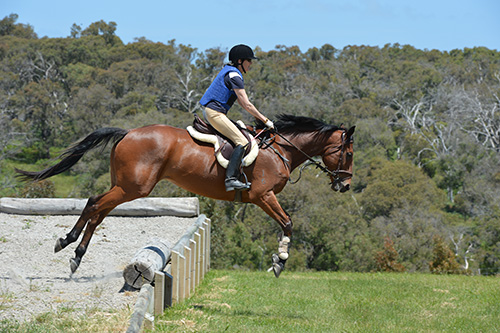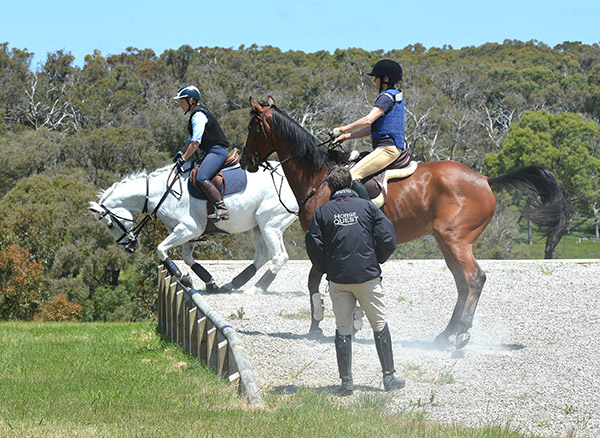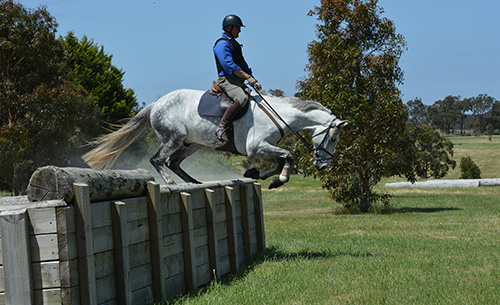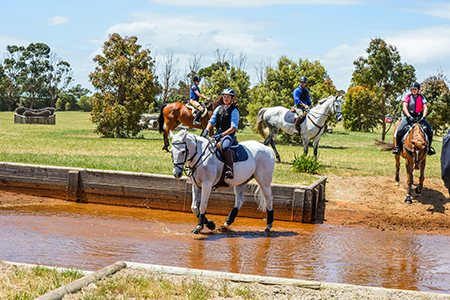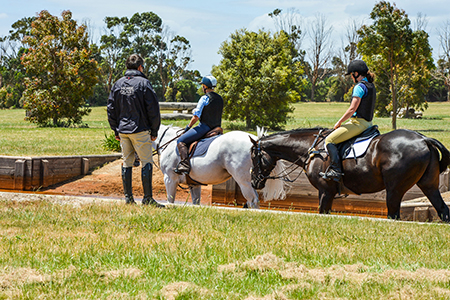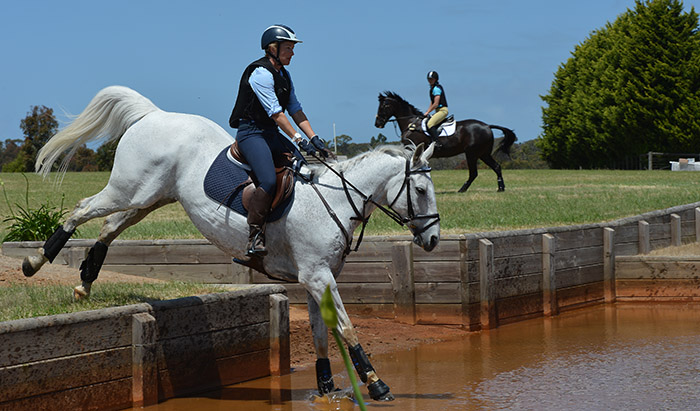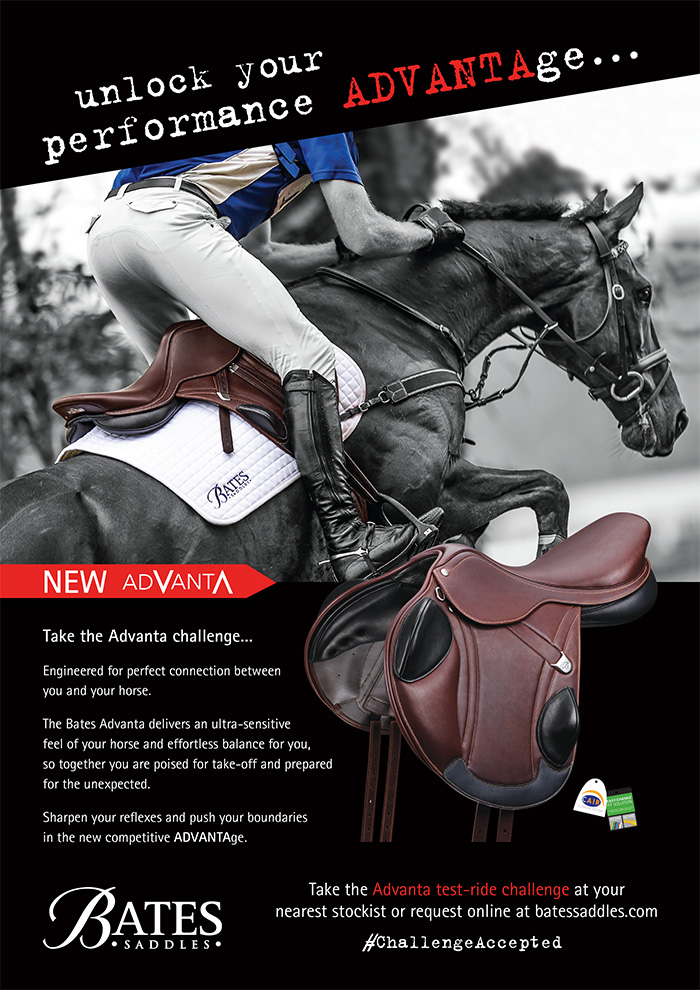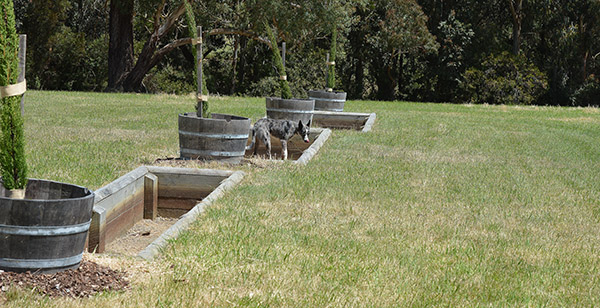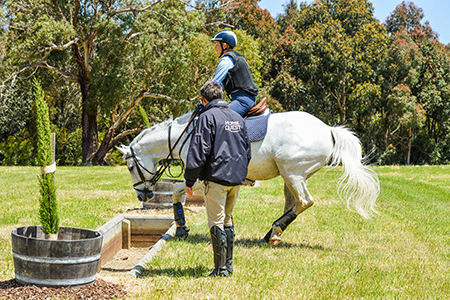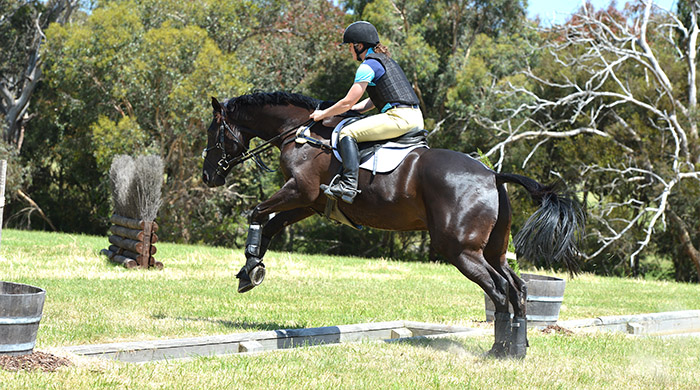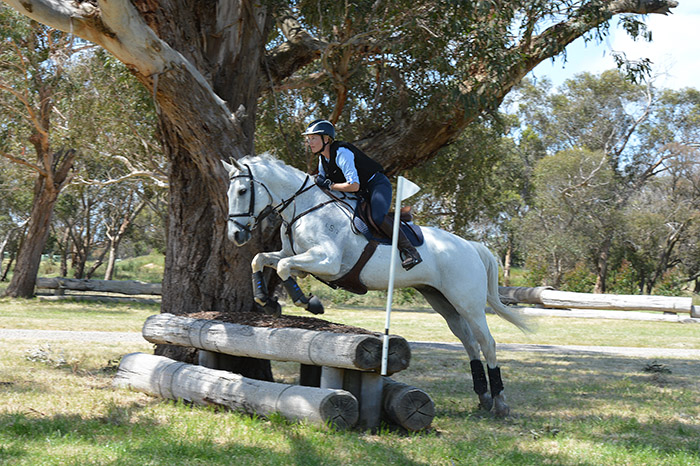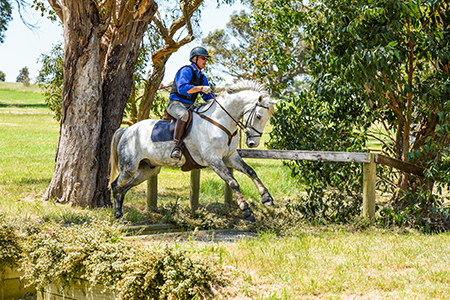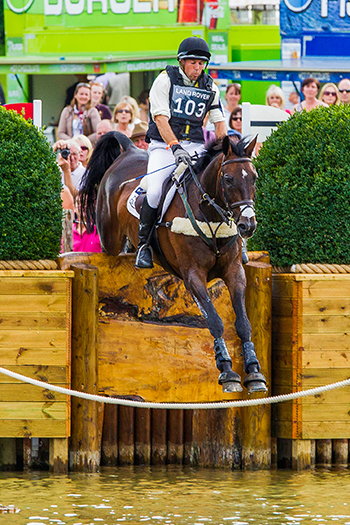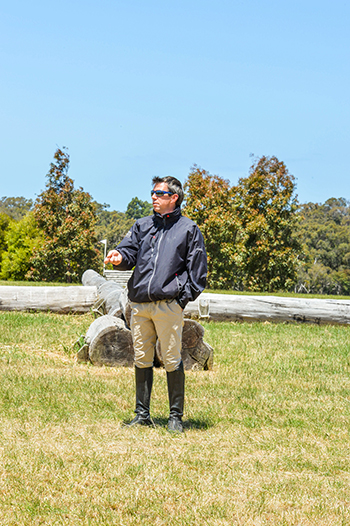Sam Griffiths, Australian Olympic and WEG representative and recently appointed New Zealand eventing coach works with young riders:
“When I’m warming up pupils for a cross country training session, I do a little exercise like this cross of logs exercise. I want to make sure the riders’ brakes and accelerator are working, not just cruise around, and then start cross country and go one, two, oops we’re out of control.”
Story by Susan Mackenzie & Photos by Roz Neave
Sam’s message is universal for all riders, whatever level they’re competing at.
The cross of logs exercise, ideal for warming up
“When I take a horse out to school on a cross country course, I ask myself, ‘what am I doing?’ Well I’m training my horses, I’m not testing them. The test of my training is at a competition.”
“I like to take my horses very slowly when I’m training, so they know what they need to do and understand your leg. Once they understand, then you add back in the speed.”
“We want to let horses learn to look after themselves, because you’d be amazed by how horses can get themselves out of trouble.”
“When training I just introduce fences at walk, get them confident and then at canter.”

They start with a bank, which has options for every level. One rider comments, “I hate banks, I know that they’re conceptually fine, but…” But Sam plans to work today on the jumps that make cross country different – banks and ditches and hills and water.
“With the bank we allow them to put their heads down, they can pop off like they’re an old man, what we do as a rider is stay in balance like we did in the arena with our legs, so keep a long rein and pop off, if you have a short rein they will jump out.”
There are some young horses that aren’t too thrilled by the bank and Sam is quick to say, “when these young horses do it really make a fuss of them.”
Having let the horses see exactly what’s going on and assuring them it’s not scary the riders then go over at trot and then immediately again at cross-country canter. Sam’s point is that the basis has to be easy and reassuring for the horse, it’s not a matter of teaching them to jump out here, it’s about teaching them to trust you and to have a positive experience.
They move on to the higher part of the bank and canter straight off it, “canter up, reins up, ready with your body, let him get his head down to see it.”
“Can you see how giving your inexperienced horse the reins it gave him confidence to see what he had to do?”
The riders pop on and off the bank, jumping a little brush afterwards, “You’d be amazed by how horses learn about what they need to do in combinations, but they have to trust that you’re not putting them in a scary place.”
We move on to the water jump, again designed to cater for all levels, tackling the easiest part first at walk, letting the horses have the rein and figuring it out for themselves, then moving up to cross-country pace.
“Horses do things without understanding what they’ve done, so it’s better to take it easy and really let him switch his brain on to where his feet are.”
Once the horses have gone through at walk and trot it’s into cross-country canter and they cruise through, again the ones who phoofed and pawed at the water on their first try, now bowl through without worrying.”
“What you’ve got to remember is the last thing the horses want to do is hurt themselves, if we just play to that, make them understand and trust them, it’s amazing what they can do.”
The riders move to bigger drops in to the water and exits, “horses are herd animals and they will learn to follow others so like before, just walk up like they’re an old plodder out on the high plains and let them have a look. Then it’s cross-country canter and all go through.”
next it’s on to ditches
Next it’s on to the ditches. Over to the other side of the hill where we find three ditches of different widths.
Sam gets the riders going over the narrowest ditch, again they walk, letting the heads go down, “we need a bit of repetition here because you can see some of them are saying ‘I don’t know what to do’.”
Then it’s more of the same and on to trot and cross-country canter. Now the horses are doing it by themselves, the rider doesn’t need to push and pull because the horse trusts them, they just need the rider to be there, “at a competition you might need to adjust the speed but the main thing is to get them to understand.”
They move on to an apex.
“For me training a young horse to jump apexes you jump them square on at the front, ride a bit of an oxer at 90 degrees to the front of the jump. At the higher levels I’ll adjust the angle and get them jumping on the angle, but here just keep it simple for them and don’t worry about the other side.”
Sam adds in a second apex, “so it’s just oxer to oxer on a bendy line, nothing scary.”
Moving on, and we’re tackling all the tricks of cross country, so next it’s a ditch at the bottom of a shadowy gully. A young dappled grey doesn’t like the shadows and spooks at the ditch, so they go through three more times, as Sam said, repetition is the key, and when asked again at canter, there is no hesitation.
Sam then sends the riders off on a course: one jokes, “wow we’ve got our solo ticket!”
While they are bowling around Sam chats about his training, commenting on the increasing technicality in cross country and how this affects his schooling: “I school over skinnies in the arena, it’s just my showjumping training with a different focus, my cross country schooling is more banks, ditches, waters, like I’ve done today. They don’t need to learn to jump out here on the course, that’s for the arena.”
The dog is in the way of the course the riders are on, and as we call it back to us it looks quite insulted by this bunch of interlopers roaming across his property.
Roz and I had a chat to Sam before he headed out to the cross-country jumps…
You have quite a mixed bag of horses and riders for cross country, how do you balance the different levels and abilities?
“Well I have the same principle for training from the start right through to the advanced horses so I’ll just do the same but over smaller fences for the less experienced horses. You know it’s just about building up the horses’ confidence so the riders will just do what they feel comfortable with and hopefully it will go well…”
Do you do much teaching in the UK?
“I do a bit, I’m usually so busy competing, it’s quite tricky, but I do the odd clinic here and there, which I quite enjoy doing, particularly the cross country side of things, today you’ve come and seen some challenging students!”
How long have you been based in the UK?
“About 15 years now, I only went over originally to travel around and I worked for a short time with Blyth Tait and Matt Ryan, and one thing led to another and I sort of stayed over there. I really miss home, but there’s such a great circuit over there, I’m quite established now so I’ll be staying there for a while…”
So with younger riders thinking about heading over, you see it with showjumpers especially, what would you advise, do you think you made the right decision?
[Sam laughs] “Career-wise yes, it’s the best circuit in the world over there, but it is very much a lifestyle choice, Australia is such a beautiful country to live in, but career-wise Europe is the place to be, I think anyway. But having said that, there’s riders like Stuart Tinney who have proved that you can do it just as well from here… It’s a big decision to leave your home and your base…”
What would you say to people like your talented nieces who might be thinking of going over there?
“I think if they wanted to do it I’d say come over for a short stint and see if it’s for them. I mean come over and try it for a while, don’t overly commit yourself until you’ve had a taste, do a season or half a season and see what you think. The hardest thing about leaving home is you lose all your connections and support group. It’s great when you’re going well, but it’s when things aren’t going so well that you need the support and that’s what makes going abroad so tough…”
Plans for Happy Times…
“I will take him to Badminton this year, and I’ve got another horse, an Irish mare with unusual name of Paulank Brockagh, that I’m going to take to Badminton as well. She’s a promising horse.”
You’ve had some good runs at those big events…
“Yeah, they’ve gone pretty well, I just haven’t quite cracked at representing Australia… but I think if I just keep plugging away I’m sure I’ll get there…”
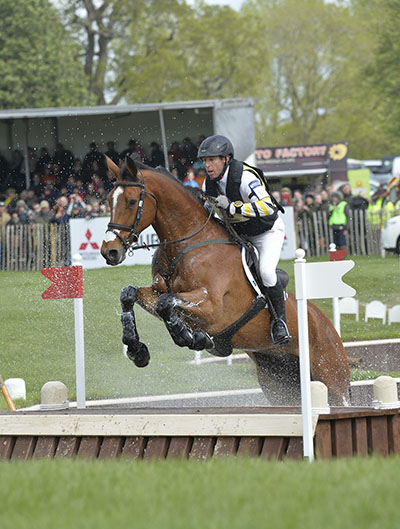
And Sam’s prediction on Pauline Brocklagh proved correct. The combination won Badminton in 2014.
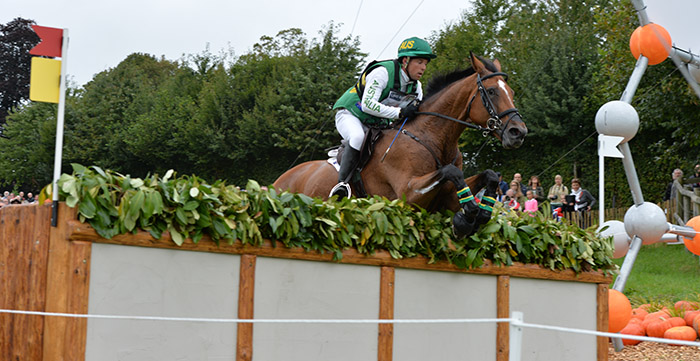
They were part of the WEG team at Normandy…
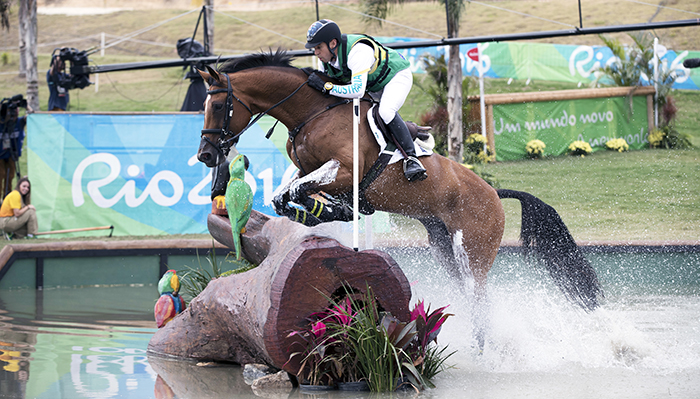
And part of Australia’s Bronze Medal Team at Rio – Hippo foto
